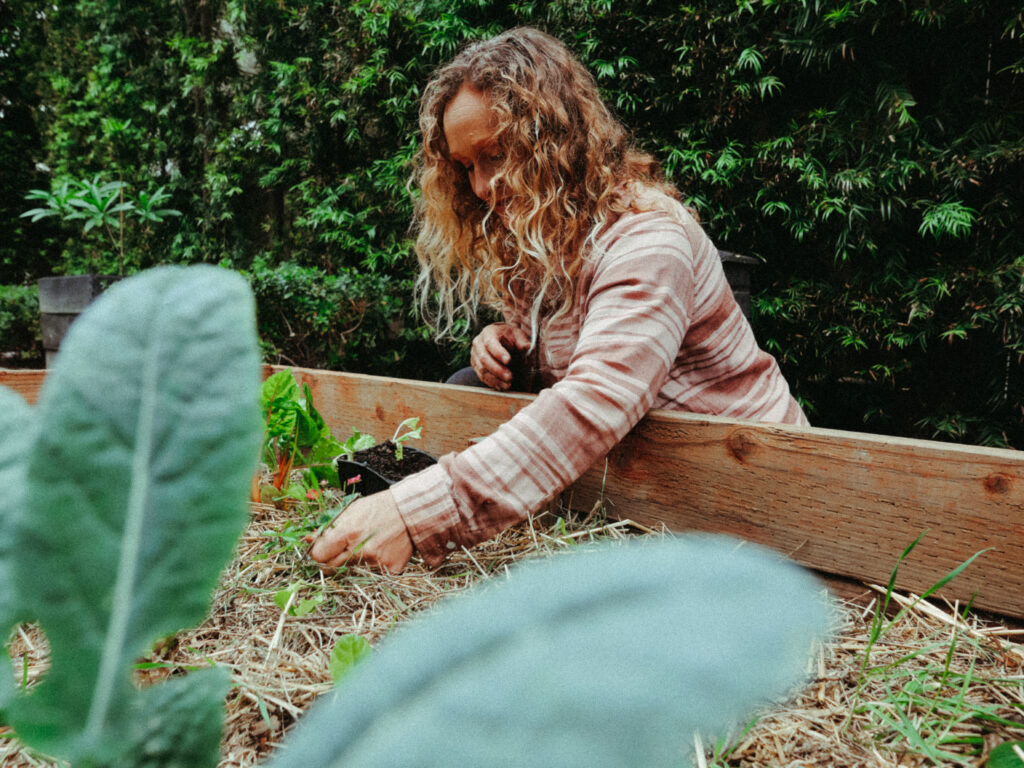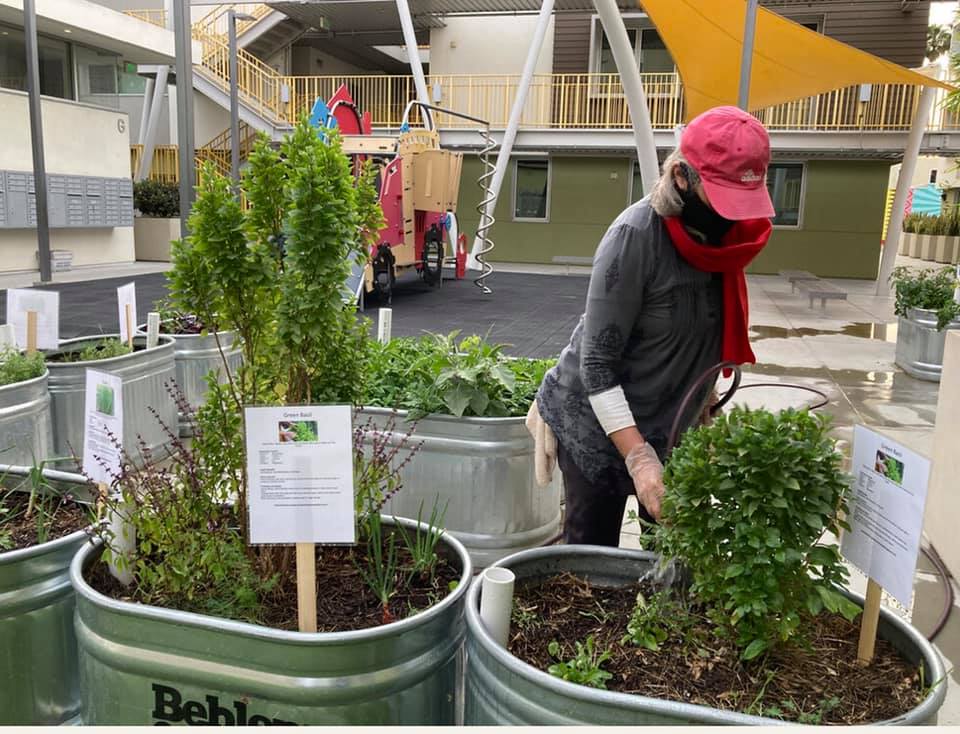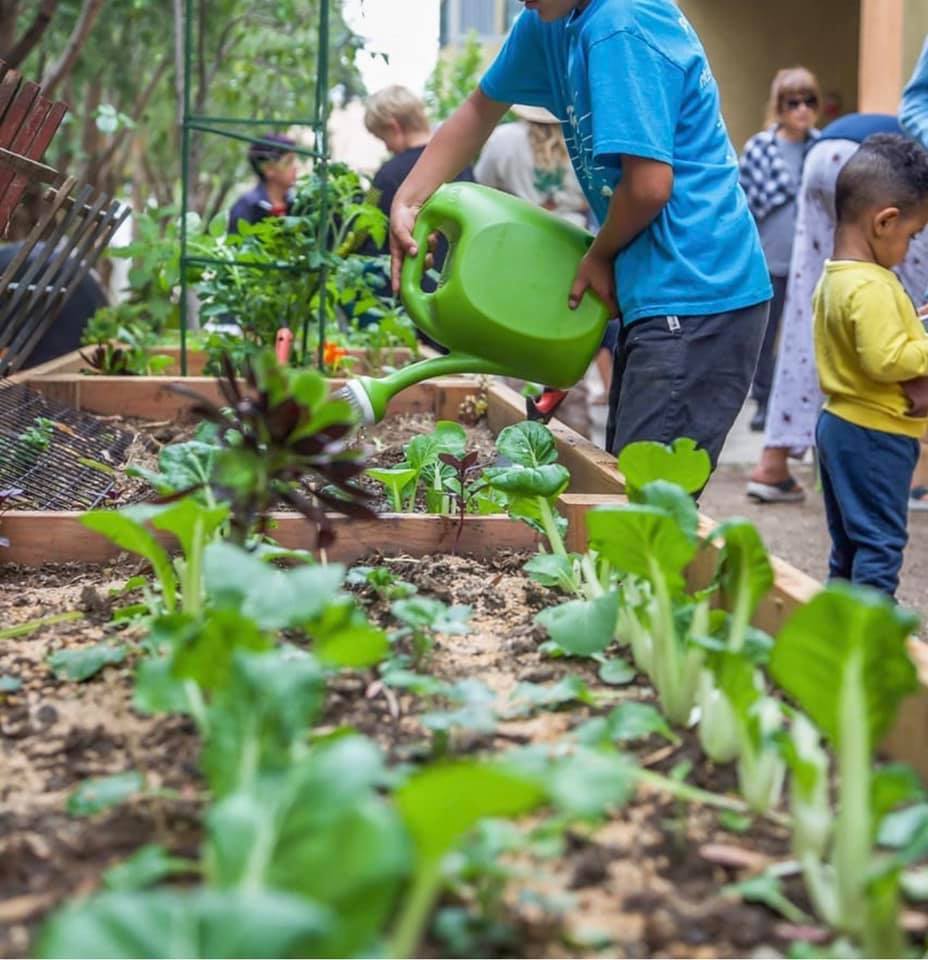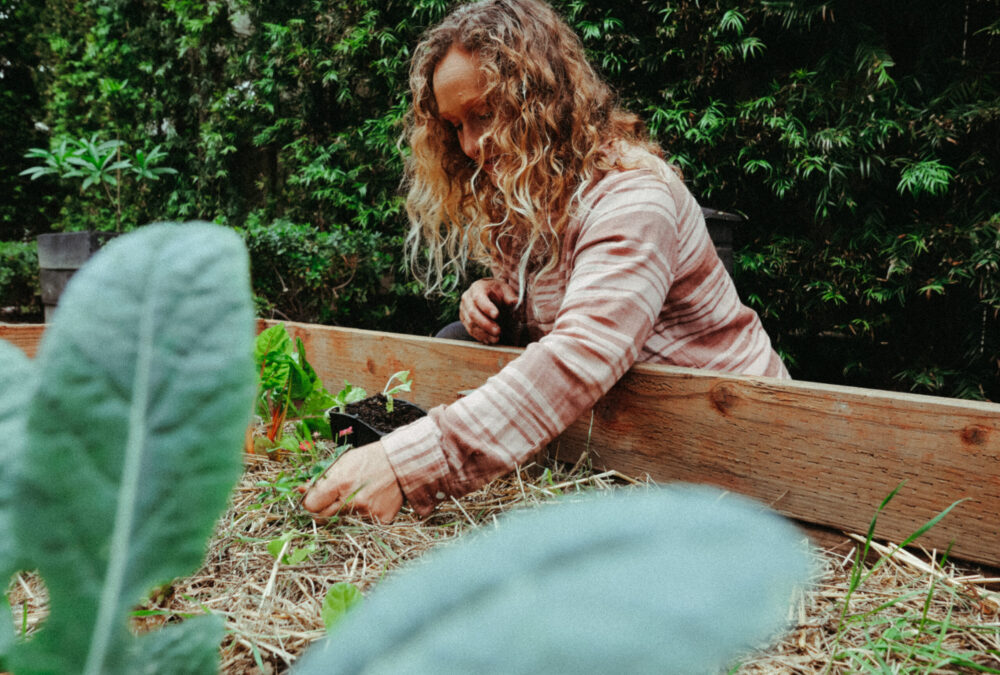
Carolyn Day was in Malibu two years ago when she crossed paths with an 82-year-old man, who seemed to be suffering from dementia. The man shared he had no family nearby, perhaps no family at all, and through the confusion of his illness, he had become unhoused.
Carolyn decided to advocate for him and took him to SAMOSHEL (SAnta MOnica SHELter), the closest shelter for the unhoused. SAMOSHEL offers interim shelter to 70 persons and is home to two Ocean Park Community Centers (OPCC) with social services programs: Wellness Beds Program that provides nursing services to clients with acute or medical conditions, and the OPCC High Need Room for clients with special challenges.
At the time, Carolyn was a master gardener, through a university program providing intensive horticultural training to persons who then volunteer in their communities; building gardens, leading research, planting seeds. She noticed at SAMOSHEL that there were two garden beds. While she was observing the perimeter of the garden, a man in a wheelchair emerged from the building, a bucket of water on his lap.

“He would water the garden bed with his bucket, roll back into the building, fill it up, roll back out. I asked him to tell me about his garden. Nobody ate from it because he liked to chemically treat it with pesticides to keep the bugs out, a small gap in the holistic approach to gardening but the intention was there, and it was beautiful.”
A few visits to SAMOSHEL later, Carolyn learned that the man in the wheelchair was terminally ill. He confided with her that he was saddened by the idea of his passing because he felt that with his passing, his pride in life — his garden, would also fade.
“It was then that I let him know I would take care of his garden after he died,” Carolyn says. She went to the social workers and explained to them that she was going to visit once a week. “The next thing you know the social workers are telling me the residents are always asking, ‘When’s the Garden Lady coming back?’”
“Homelessness is an incredibly isolating experience,” Carolyn explains. “Some of them have felt so unwanted in their lives, that they didn’t know if they had permission to plant a seed, which is such a basic human action”, she shares. Before she was 18, Carolyn also experienced homelessness without family, so she knew that feeling of not belonging. When residents of the shelter approached her and asked if they could have a seed, or if they were allowed to take a watering can and water the plants, it resonated with her.
“I knew that feeling so deeply…like you’re on the outside. Other people have their stuff figured out and you’re on the sidelines.” Knowing this feeling was the impetus for her non profit, Growing Hope Gardens.
I visited Carolyn at an affordable housing building in Santa Monica, reinforced by the Community Corporation of Santa Monica. At the site, children are heard giggling and playing inside the building, curious hummingbirds chirp and zip busily around.
“We don’t think about Santa Monica as a city with lots of affordable housing, but in a way it is,” she says. “There are different kinds of poverty in our country. Living in a food desert for example, or living off tribal land, and then there’s living in a really wealthy city. It adds a degree of challenges including food is more expensive.”

While checking on different thriving edibles growing in the beds—chard, leeks, celery, strawberries, lettuce, Carolyn shares that at the start of her program her aim was to grow food in an urban environment, tending to one another along the way. But when the pandemic hit, all the parks closed. “These residents don’t have balconies. When they leave their house they are very much in a public sphere, so having this space has meant a lot to them. They can come out and have a moment with their family. I saw a family the other day lay a blanket between the garden beds. Recess and snack time happen in the garden now.”
The gardens have grown from being a way to connect with the earth, to actually alleviating some community hunger. In the beds you see less uniformity and the presence of vibrant traditional herbs. “There is always such interesting customization of the beds. Look there is a plumeria growing out of the compost. You can see here there are people from all over living in this affordable housing building, asylum seekers. I find plants specific to different parts of the world.”
One of the challenges of urban gardening is lack of irrigation. None of their gardening beds have irrigation, as it is too costly. Carolyn goes on to point out all around us how many trees have irrigation. “There should be food growing all around the area. A corporation will find it reasonable to irrigate ornamental trees.”
How does one grow food in a city without irrigation? Through innovation like ‘wicking beds’. “Wicking beds are started in a wooden or metal tank, we put in a drop in liner to make it water protected, at the bottom we put lava rocks, on top of that a coat of landscape fabric and soil, the lava rock bottom becomes a water holder, and we fill it with a pipe every two weeks. The plants learn to wick from the bottom. It allows us to grow food with no irrigation, which is so important in urban gardening.”
This year, through the Safe Place For Youth Garden Internship Program, Growing Hope Gardens hired their second intern. UCLA Youth Force pays for the intern’s first 100 hours of work. “It is a really soft landing,” Carolyn says. “They can not show up for work, not respond for some time, we forgive and we train.” Forgiveness is a part of a strong foundation. Many residents of programs like these have not paid rent since last April, when the pandemic began.
Growing Hope Gardens tends to nine different urban gardening projects on the Westside. Two of them are at homeless shelters. “Each community decides how they’re going to divvy up the garden, whether it is going to be one garden bed per family, or perhaps a community garden where everyone has harvesting rights.”
I ask her what she needs to thrive in the next coming years. The answer? Funding and hands.
“There are more gardens than I can open and there are more needs than I can get funding for. There is a home with a hundred unhoused children, some of them babies. They go from a windowless classroom to a windowless room through a windowless hallway. There is this feeling that a child is being born somewhere where it’s practice for incarceration…being okay with that sort of institutionalized feeling. I want them to be free to pick strawberries or study perimeters in the garden with their teachers.”
Connect with Carolyn Day @dayinthesurf
Growing Hope Gardens
www.growinghopegardens.org @growinghopegardens
www.thepeopleconcern.org @thepeopleconcern
www.communitycorp.org @communitycorp













